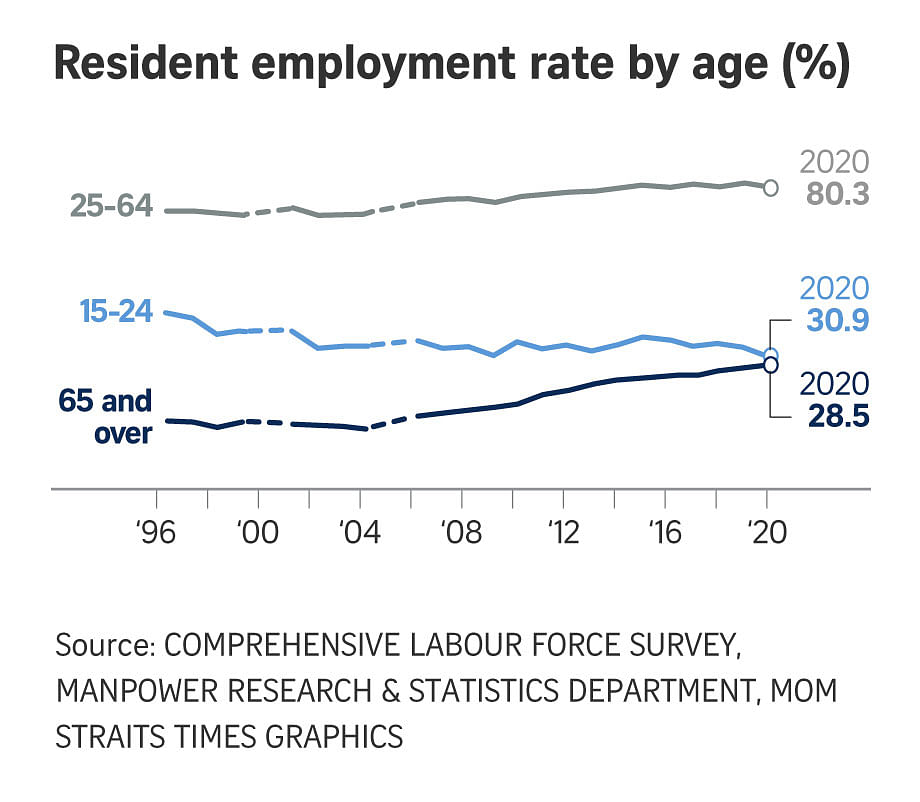MOM to focus on overcoming skills gaps for new jobs
This will give employers confidence to take on new hires and trainees: Josephine Teo
Sign up now: Get ST's newsletters delivered to your inbox

Manpower Minister Josephine Teo with Ms Roslina Mohd Sharif, 49, a controller at the Secura Integrated Command Centre, during a visit yesterday. Employment of local residents - Singaporeans and permanent residents - rebounded in the third quarter, and Singapore must build on the gains even as some support measures like the Jobs Support Scheme taper off, said Mrs Teo.
ST PHOTO: LIM YAOHUI
Follow topic:
The jobs that will appear in Singapore's post-recession economy are likely to be different from those that vanished in the slump, and may be in fields that displaced workers are not familiar with.
For this reason, the Ministry of Manpower (MOM) will focus on overcoming skills gaps to give employers confidence to take on new hires and trainees, said Manpower Minister Josephine Teo yesterday.
This will be reinforced by the support schemes in place, she added, citing the Jobs Growth Incentive which spurs employers to hire more locals, the SGUnited traineeship and mid-career pathways programmes, as well as professional conversion programmes and skills upgrading programmes.
She also said her ministry is taking a very close look at refining and enhancing these schemes "to better support the need to close the gaps between what employers are looking for and what the job seekers have to offer".
The minister was speaking at a press conference on the preliminary mid-year data on the labour force, a report that covers a range of indicators from employment rates and incomes to working hours.
These steps are necessary as Singapore returns to a path of job growth in the current phase of recovery, and MOM will work with other agencies to ensure economic activities return and have the chance to expand, because only then can job opportunities have the scope to grow.
Employment of local residents - Singaporeans and permanent residents - rebounded in the third quarter, and Singapore must build on the gains even as some support measures like the Jobs Support Scheme taper off, she added.
Although retrenchments and unemployment rates rose due to the Covid-19 pandemic, cooperation among unions, employers and the Government helped lessen the pandemic's impact on local employment rates at its peak, she said, noting their positive responses.
Unions and workers accepted wage cuts, increased training and redeployments while employers strived to retain their local workforce as the Government rolled out schemes like the SGUnited Jobs and Skills Package.
"The overall outcome is that when we looked at the peak of the pandemic and its impact on the workforce, employment rates actually remained fairly high," she said.
However, young people aged 15 to 24 suffered the most, according to the MOM report. The fall in their employment rate was the steepest among all the age groups, dropping to 30.9 per cent in June, from 33.9 per cent a year earlier.
The reason is the sectors they tend to work in, such as food and beverage, administrative and support services, and retail trade, saw employment shrink significantly.
But their rate has been on a downward trend in recent years as more young people further their studies, MOM said.

In contrast, 28.5 per cent of older residents aged 65 and over were employed in June this year, up from 27.6 per cent. This reflects sustained efforts to boost their employability and higher demand for essential services such as cleaning and security owing to the virus outbreak, it added.
For residents aged 25 to 64, who make up the bulk of the workforce, the employment rate dipped slightly to 80.3 per cent, from 80.8 per cent last June. It remained close to the average of 80.5 per cent in the past five years.
The employment rate for men fell more steeply than for women.
It dropped from 88.8 per cent to 87.9 per cent for men, the lowest level since 2004, while that for women dipped just a tad, from 73.3 per cent to 73.2 per cent.
The resident labour force participation rate remained stable, helped by rising numbers of mature workers.
But as the economy reeled from the impact of Covid-19, a record number of residents stopped looking for work because they felt it would be fruitless. This group swelled to 16,400, or 0.7 per cent of the resident labour force, in June. This is more than double the group's size last year and higher than the previous peak of 11,100 in the 2009 recession.
Lower-educated and older residents remained the largest groups among such discouraged workers.

